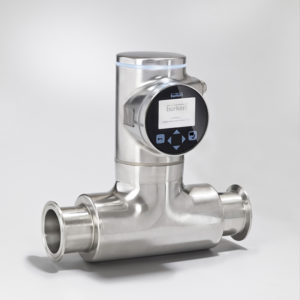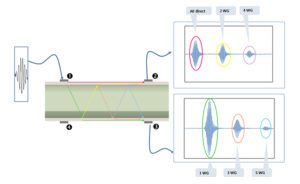 Until now flowmeters have come in a wide variety of designs with individual strengths and weaknesses that define their suitability for different applications. This status-quo is about to change however as Bürkert, a company known for producing high quality process control equipment for the hygienic processing sector, has developed FLOWave an innovative solution for liquid flow measurement, which has the potential to change the market significantly. The revolutionary FLOWave design uses new technology based on Surface Acoustic Waves (SAW) to deliver unrestricted, highly accurate measurement even in turbulent or laminar flow.
Until now flowmeters have come in a wide variety of designs with individual strengths and weaknesses that define their suitability for different applications. This status-quo is about to change however as Bürkert, a company known for producing high quality process control equipment for the hygienic processing sector, has developed FLOWave an innovative solution for liquid flow measurement, which has the potential to change the market significantly. The revolutionary FLOWave design uses new technology based on Surface Acoustic Waves (SAW) to deliver unrestricted, highly accurate measurement even in turbulent or laminar flow.
From the most basic paddle wheel system to an advanced Coriolis flowmeter, each and every design has one or more operational constraints which must either be accepted and managed or rejected in favour of a different design that is more suitable. Most of the mechanical flowmeters for example have moving parts that require direct contact with the fluid flow which can cause a restriction to the flow as well as hinder any hygienic cleaning process.
The more advanced non-contact technologies such as ultrasonic, electro-magnetic and Coriolis sensors still have limitations, especially with liquids that are non-conducting, contain bubbles or debris. In addition, the orientation, size, weight, mounting length and location of most current flowmeters can be determining factors in deciding which design is best suited to a particular application. Bürkert has looked to address all of these issues in the creation of the new flowmeter design which has the potential to transform the market in terms of liquid flow measurement.
Surface Acoustic Wave (SAW) technology
The main principle of this flowmeter is based on wave propagation forms similar to seismic waves, which start from an initial point of excitation and spread along the surface of a solid material. FLOWave uses at least four interdigital transducers which are located on the outside of the measuring tube and therefore have no direct contact with the liquid. Each transducer can act as a transmitter or a receiver.
Figure 1. Shows one transducer emitting the wave, part of which travels directly to the first receiver, part of the same signal is transmitted through the liquid to the opposite side of the tube, where it splits again, with a proportion of the signal going to the second receiver and the remainder travelling through the liquid where the process repeats itself. Thus, a single excitation leads to a sequence of signals being received by two other transducers.
The absolute time for the wave to travel from the transmitter to the receiver depends mainly on the tube diameter and the type of liquid. The difference between the time of propagation in the forward and backward direction is proportional to the flow. The analysis of all the signals and comparisons based on different criteria such as amplitude, frequency and runtimes, allows evaluation of the quality of the measurement, the existence of gas bubbles or solids as well as the kind of liquid.
Benefits to users
The first and most obvious advantage to this technology is that none of the components come into contact with the liquid and there are no flow restrictions inside the measuring tube. Furthermore, the internal surface of the tube can be manufactured to the same surface finish as the rest of the pipeline, meaning that in terms of hygiene, cleaning and flow conditions, there is no difference to any other piece of straight pipe.
This measuring system currently provides very accurate flow and temperature data and the technology will, in the future; allow density measurement to be used to determine the mass flow rate. The principles behind this design enable the flowmeter to work with a stagnant liquid and so reliable flow figures are available even for the smallest flow volumes. The technology also enables it to recognise quick flow changes reliably, which makes it suitable for fast filling processes. FLOWave also solves many of the issues associated with some high-end flowmeters, such as system vibration in the plant, magnetic and electrical effects as well as the conductivity of the liquid – none of these factors have any effect on the accuracy or reliability of the flow measurements; plus, the SAW technology also has the ability to distinguish between laminar and turbulent flows, a feature that will available later.
Not only does this revolutionary design come in a compact and simple design, but this flowmeter can also be installed in applications in any orientation without affecting performance. The initial design, Type 8098, will comprise an all stainless steel body in four sizes, DN15, DN25, DN40 & DN50, fitted with a clamp connection to meet hygienic standards. This is just the beginning of the FLOWave story, with so many suitable applications and so many advantages, it is predicted the range will grow to provide additional solutions for a much wider audience, enabling more processes and industry sectors to benefit from SAW flow measurement technology.




